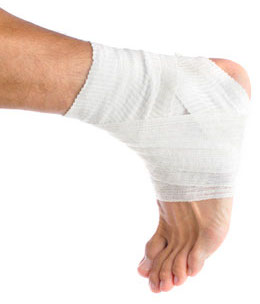Swollen ankles of feet is often attributed to fluid retention. Ankle sprains, pregnancy, use of certain drugs, or other medical conditions could be other contributing factors. This Buzzle article provides some remedies or self-care measures for alleviating the swelling.

The term 'edema' refers to the swelling caused by abnormal accumulation of fluid beneath the skin, or in the body cavities. When the retention of fluid occurs in lower limbs or extremities, it is referred to as peripheral edema. Fluid retention in the ankles and feet could be attributed to congestive heart failure, rolled ankle/sprain, pregnancy, hypertension, injury to the ligament/tendons in the ankles, sitting in a position for an extended period, the use of certain drugs, venous insufficiency, blood clots in the veins of the legs that prevent the return flow of blood from the legs to the heart, etc. In severe cases, edema could also be accompanied by skin changes, ulcers, etc.
Remedies for Swollen Ankles
More often than not, peripheral edema affects the elderly. The contributing factor could be lack of physical activity. Ankle swelling could occur, if most of the time is spent while sitting or standing at one place. The following measures can be followed for alleviating the swelling:
➠ Walking around will improve the blood flow to the lower limbs, and decrease the swelling. Even when you are sitting it is recommended that you flex and point your toes and heels every few minutes. This will also improve blood circulation to the feet and ankles.
➠ Performing simple exercises would help improve circulation and the distribution of fluid. You could sit on a carpet and stretch the right leg in front of you. Lift the leg off the floor, and rotate it 10-15 times in clockwise direction. Thereafter, move the leg 10-15 times in anti-clockwise direction. Repeat the same with the other leg.
➠ Fluid retention could also affect pregnant women. They should also avoid sitting or standing at one place for long periods. Pregnant women, as well as those who have been advised to take complete rest, could elevate their feet by propping them up on pillows. Since high blood pressure and swelling could be a sign of preeclampsia in pregnant women, it's advisable to consult your gynecologist in case of severe swelling.
➠ If the ankle swelling is due to a sprain/rolled ankle, then it would be best to apply an ice pack. Application of an ice pack would not only provide temporary pain relief, it would also help reduce the swelling.
➠ Mix vinegar and water in same quantity and heat it. Soak a towel in this mixture, wring it out, and wrap it around your foot. Leave the compress for about 5 to 6 minutes. Then, mix vinegar and cold water in the same manner and follow the same procedure. Perform this method thrice a day.
➠ Follow a healthy diet. It is essential to cut down on the intake of salt. Excessive intake of salt could put you at a risk of developing fluid retention, hypertension, or swelling.
➠ Individuals who are overweight are at a greater risk of developing peripheral edema. So, exercise and eat properly to lose excess weight.
➠ At times, the use of certain drugs could be responsible for edema. So, inform your healthcare provider, if the onset of edema seems to be linked to the use of any drug.
Diuretics are often recommended for treating fluid retention. However, it's advisable to identify and treat the underlying cause of edema at the earliest.
Disclaimer:
The information provided in this article is solely for educating the reader. It is not intended to be a substitute for the advice of a medical expert.


 The term 'edema' refers to the swelling caused by abnormal accumulation of fluid beneath the skin, or in the body cavities. When the retention of fluid occurs in lower limbs or extremities, it is referred to as peripheral edema. Fluid retention in the ankles and feet could be attributed to congestive heart failure, rolled ankle/sprain, pregnancy, hypertension, injury to the ligament/tendons in the ankles, sitting in a position for an extended period, the use of certain drugs, venous insufficiency, blood clots in the veins of the legs that prevent the return flow of blood from the legs to the heart, etc. In severe cases, edema could also be accompanied by skin changes, ulcers, etc.
The term 'edema' refers to the swelling caused by abnormal accumulation of fluid beneath the skin, or in the body cavities. When the retention of fluid occurs in lower limbs or extremities, it is referred to as peripheral edema. Fluid retention in the ankles and feet could be attributed to congestive heart failure, rolled ankle/sprain, pregnancy, hypertension, injury to the ligament/tendons in the ankles, sitting in a position for an extended period, the use of certain drugs, venous insufficiency, blood clots in the veins of the legs that prevent the return flow of blood from the legs to the heart, etc. In severe cases, edema could also be accompanied by skin changes, ulcers, etc.